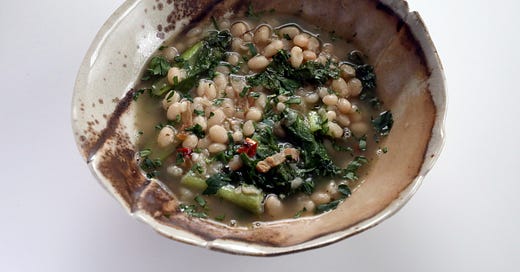I first had this in Tuscany, and it’s a perennial favorite—especially given how much escarole (and related chicories) I grow. Because I live in zone 6a now, even though it got savagely cold for a couple of spells last winter almost an entire bed of chicory came roaring back once spring arrived. It’s pretty cold-hardy, and a mostly biannual species (meaning it sends up flowers which form seeds in its second year) but I’ve never had more than a few plants survive the winter.
Because chicory shifts its focus to producing flowers and seeds, you need to cut it fairly early in the second growing season since the leaves become seriously bitter once that change occurs. While complex bitterness is one of chicory’s great attractions, when the plants begin to bolt it reaches unpalatably high levels. So I dutifully mow down all my regrown chicory for early spring salads and cooked dishes while I wait for the new plantings to come in. And I always leave a few to flower for the pollinators.
The key to cooking with chicories lies in understanding how to moderate bitterness through cooking and the addition of other flavors. This soup makes tasty work of these simple tricks, and of course can be configured lots of different ways depending on what you have handy. If you soak your beans overnight, this whole thing comes together easily in about half an hour. And there’s something about the combination that makes it work all year round—it’s as perfect as part of an al fresco midsummer dinner as it is on a bitter (see what I did there?) winter evening or a soggy spring afternoon (like today).
It’s also easily converted into a vegetarian or vegan version without sacrificing any depth of flavor. Here’s everything you need to know to conjure this quiet miracle in your very own kitchen:
Keep reading with a 7-day free trial
Subscribe to Things On Bread to keep reading this post and get 7 days of free access to the full post archives.





